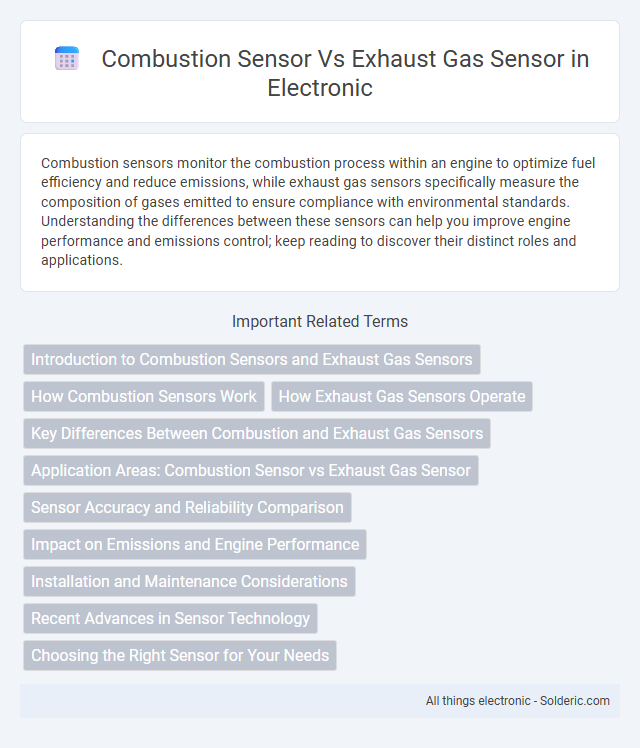Combustion sensors monitor the combustion process within an engine to optimize fuel efficiency and reduce emissions, while exhaust gas sensors specifically measure the composition of gases emitted to ensure compliance with environmental standards. Understanding the differences between these sensors can help you improve engine performance and emissions control; keep reading to discover their distinct roles and applications.
Comparison Table
| Feature | Combustion Sensor | Exhaust Gas Sensor |
|---|---|---|
| Purpose | Monitors combustion quality in engines or furnaces | Measures composition of gases in exhaust emissions |
| Measurement Focus | Temperature, flame detection, combustion efficiency | Oxygen levels, CO, NOx, hydrocarbons in exhaust gases |
| Common Types | Flame sensors, thermocouples, ionization sensors | Lambda sensors (O2 sensors), NOx sensors, CO sensors |
| Applications | Boilers, furnaces, gas turbines | Automotive emissions control, environmental monitoring |
| Output Data | Real-time combustion status and quality indicators | Gas concentration levels for emission regulation compliance |
| Installation Location | Inside combustion chamber or flame path | Exhaust system or tailpipe area |
| Impact | Optimizes combustion efficiency and safety | Reduces pollution by controlling emission output |
Introduction to Combustion Sensors and Exhaust Gas Sensors
Combustion sensors monitor the efficiency and safety of fuel burning by detecting parameters such as flame presence, temperature, and oxygen levels, ensuring optimal combustion performance. Exhaust gas sensors analyze the composition of emissions, particularly gases like CO, CO2, NOx, and hydrocarbons, to control pollution and enhance engine efficiency. Your choice between these sensors depends on whether precise combustion control or emission monitoring is the primary goal in your application.
How Combustion Sensors Work
Combustion sensors monitor flame presence and quality by detecting ionization currents or optical signals within the combustion chamber, ensuring efficient fuel burning. Exhaust gas sensors measure specific gas concentrations like oxygen or carbon monoxide in the exhaust stream to assess combustion completeness indirectly. Both sensors optimize system performance and emissions control but operate on fundamentally different detection principles.
How Exhaust Gas Sensors Operate
Exhaust gas sensors operate by detecting specific gases within vehicle exhaust, such as oxygen, carbon monoxide, and nitrogen oxides, to monitor combustion efficiency and emissions. These sensors use chemical or electrochemical reactions to generate signals proportional to gas concentrations, allowing your engine control unit to adjust fuel-air mixture for optimal performance. Accurate readings from exhaust gas sensors are crucial for reducing pollutants and improving fuel economy.
Key Differences Between Combustion and Exhaust Gas Sensors
Combustion sensors monitor the ignition and flame conditions inside boilers or furnaces to ensure optimal fuel burning efficiency, while exhaust gas sensors analyze the composition of gases like CO, CO2, and NOx in the emissions to assess combustion quality and environmental impact. Combustion sensors provide real-time feedback for flame stability and safety, whereas exhaust gas sensors help you maintain compliance with emission regulations and optimize fuel consumption. These key differences highlight the distinct roles both sensors play in enhancing system performance and environmental responsibility.
Application Areas: Combustion Sensor vs Exhaust Gas Sensor
Combustion sensors are primarily used in industrial boilers, furnaces, and engines to monitor flame presence and optimize fuel combustion for energy efficiency and safety. Exhaust gas sensors, commonly found in automotive and HVAC systems, measure the composition of gases such as oxygen, carbon monoxide, and nitrogen oxides to control emissions and ensure regulatory compliance. Your choice between these sensors depends on whether you prioritize real-time combustion control or emissions monitoring in your application.
Sensor Accuracy and Reliability Comparison
Combustion sensors deliver precise real-time data on flame presence and quality, ensuring optimal fuel-air mixture and efficient engine operation. Exhaust gas sensors monitor pollutants and combustion byproducts, providing accurate measurements for emission control and regulatory compliance. Your choice depends on whether you prioritize immediate combustion feedback or detailed exhaust composition analysis for system diagnostics.
Impact on Emissions and Engine Performance
Combustion sensors directly monitor in-cylinder combustion quality, enabling real-time adjustments that optimize fuel-air mixture and ignition timing for reduced emissions and enhanced engine performance. Exhaust gas sensors analyze post-combustion gases, providing data on pollutant levels like NOx, CO, and unburned hydrocarbons to fine-tune the engine control unit for compliance with emission standards. Your vehicle benefits from the combined use of both sensors by achieving efficient combustion processes and lower harmful emissions, leading to improved fuel economy and reduced environmental impact.
Installation and Maintenance Considerations
Combustion sensors typically require precise placement near the burner to accurately monitor flame quality, and their maintenance involves routine cleaning to prevent soot buildup that can impair performance. Exhaust gas sensors are installed within the flue or exhaust pipe to measure emissions, demanding regular calibration and inspection to ensure accurate readings and compliance with environmental standards. You should consider ease of access and sensor durability when selecting between these sensors to optimize installation and long-term maintenance efficiency.
Recent Advances in Sensor Technology
Recent advances in sensor technology have significantly enhanced the accuracy and responsiveness of combustion sensors and exhaust gas sensors in automotive and industrial applications. Innovations such as nanomaterial-based sensing elements and integrated microelectromechanical systems (MEMS) have improved detection limits, enabling real-time monitoring of combustion efficiency and exhaust emissions like NOx, CO, and unburnt hydrocarbons. These developments support stricter environmental regulations by providing more reliable data for optimizing engine performance and reducing pollutant output.
Choosing the Right Sensor for Your Needs
Choosing the right sensor depends on the specific application and parameters to monitor. A combustion sensor primarily measures the quality and efficiency of the fuel burn process by detecting flame presence and combustion gases, optimizing fuel usage and safety. An exhaust gas sensor, such as an oxygen or NOx sensor, focuses on monitoring emissions and environmental compliance by analyzing exhaust gas composition and pollutant levels.
combustion sensor vs exhaust gas sensor Infographic

 solderic.com
solderic.com